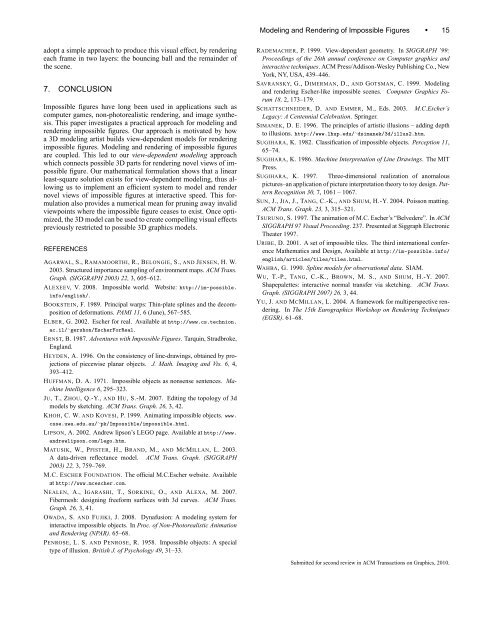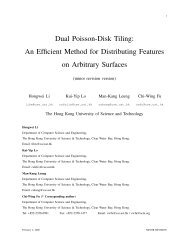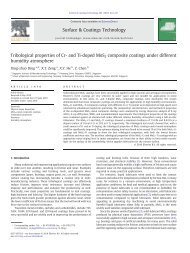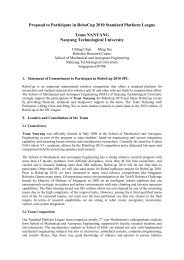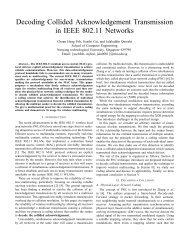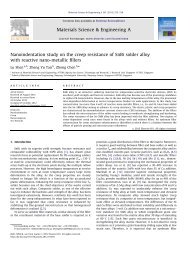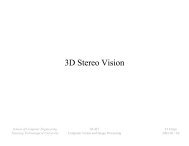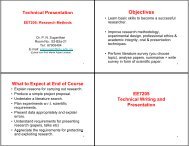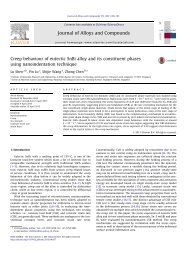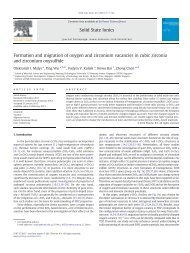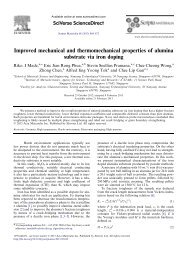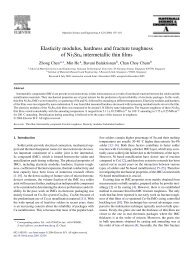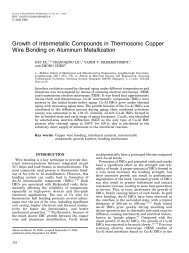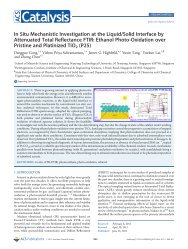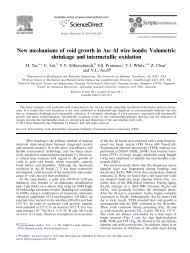ifrender - Nanyang Technological University
ifrender - Nanyang Technological University
ifrender - Nanyang Technological University
Create successful ePaper yourself
Turn your PDF publications into a flip-book with our unique Google optimized e-Paper software.
adopt a simple approach to produce this visual effect, by rendering<br />
each frame in two layers: the bouncing ball and the remainder of<br />
the scene.<br />
7. CONCLUSION<br />
Impossible figures have long been used in applications such as<br />
computer games, non-photorealistic rendering, and image synthesis.<br />
This paper investigates a practical approach for modeling and<br />
rendering impossible figures. Our approach is motivated by how<br />
a 3D modeling artist builds view-dependent models for rendering<br />
impossible figures. Modeling and rendering of impossible figures<br />
are coupled. This led to our view-dependent modeling approach<br />
which connects possible 3D parts for rendering novel views of impossible<br />
figure. Our mathematical formulation shows that a linear<br />
least-square solution exists for view-dependent modeling, thus allowing<br />
us to implement an efficient system to model and render<br />
novel views of impossible figures at interactive speed. This formulation<br />
also provides a numerical mean for pruning away invalid<br />
viewpoints where the impossible figure ceases to exist. Once optimized,<br />
the 3D model can be used to create compelling visual effects<br />
previously restricted to possible 3D graphics models.<br />
REFERENCES<br />
AGARWAL, S., RAMAMOORTHI, R., BELONGIE, S., AND JENSEN, H. W.<br />
2003. Structured importance sampling of environment maps. ACM Trans.<br />
Graph. (SIGGRAPH 2003) 22, 3, 605–612.<br />
ALEXEEV, V. 2008. Impossible world. Website: http://im-possible.<br />
info/english/.<br />
BOOKSTEIN, F. 1989. Principal warps: Thin-plate splines and the decomposition<br />
of deformations. PAMI 11, 6 (June), 567–585.<br />
ELBER, G. 2002. Escher for real. Available at http://www.cs.technion.<br />
ac.il/ ∼ gershon/EscherForReal.<br />
ERNST, B. 1987. Adventures with Impossible Figures. Tarquin, Stradbroke,<br />
England.<br />
HEYDEN, A. 1996. On the consistency of line-drawings, obtained by projections<br />
of piecewise planar objects. J. Math. Imaging and Vis. 6, 4,<br />
393–412.<br />
HUFFMAN, D. A. 1971. Impossible objects as nonsense sentences. Machine<br />
Intelligence 6, 295–323.<br />
JU, T., ZHOU, Q.-Y., AND HU, S.-M. 2007. Editing the topology of 3d<br />
models by sketching. ACM Trans. Graph. 26, 3, 42.<br />
KHOH, C. W. AND KOVESI, P. 1999. Animating impossible objects. www.<br />
csse.uwa.edu.au/ ∼ pk/Impossible/impossible.html.<br />
LIPSON, A. 2002. Andrew lipson’s LEGO page. Available at http://www.<br />
andrewlipson.com/lego.htm.<br />
MATUSIK, W., PFISTER, H., BRAND, M., AND MCMILLAN, L. 2003.<br />
A data-driven reflectance model. ACM Trans. Graph. (SIGGRAPH<br />
2003) 22, 3, 759–769.<br />
M.C. ESCHER FOUNDATION. The official M.C.Escher website. Available<br />
at http://www.mcescher.com.<br />
NEALEN, A., IGARASHI, T., SORKINE, O., AND ALEXA, M. 2007.<br />
Fibermesh: designing freeform surfaces with 3d curves. ACM Trans.<br />
Graph. 26, 3, 41.<br />
OWADA, S. AND FUJIKI, J. 2008. Dynafusion: A modeling system for<br />
interactive impossible objects. In Proc. of Non-Photorealistic Animation<br />
and Rendering (NPAR). 65–68.<br />
PENROSE, L. S. AND PENROSE, R. 1958. Impossible objects: A special<br />
type of illusion. British J. of Psychology 49, 31–33.<br />
Modeling and Rendering of Impossible Figures • 15<br />
RADEMACHER, P. 1999. View-dependent geometry. In SIGGRAPH ’99:<br />
Proceedings of the 26th annual conference on Computer graphics and<br />
interactive techniques. ACM Press/Addison-Wesley Publishing Co., New<br />
York, NY, USA, 439–446.<br />
SAVRANSKY, G., DIMERMAN, D., AND GOTSMAN, C. 1999. Modeling<br />
and rendering Escher-like impossible scenes. Computer Graphics Forum<br />
18, 2, 173–179.<br />
SCHATTSCHNEIDER, D. AND EMMER, M., Eds. 2003. M.C.Escher’s<br />
Legacy: A Centennial Celebration. Springer.<br />
SIMANEK, D. E. 1996. The principles of artistic illusions – adding depth<br />
to illusions. http://www.lhup.edu/ ∼ dsimanek/3d/illus2.htm.<br />
SUGIHARA, K. 1982. Classification of impossible objects. Perception 11,<br />
65–74.<br />
SUGIHARA, K. 1986. Machine Interpretation of Line Drawings. The MIT<br />
Press.<br />
SUGIHARA, K. 1997. Three-dimensional realization of anomalous<br />
pictures–an application of picture interpretation theory to toy design. Pattern<br />
Recognition 30, 7, 1061 – 1067.<br />
SUN, J., JIA, J., TANG, C.-K., AND SHUM, H.-Y. 2004. Poisson matting.<br />
ACM Trans. Graph. 23, 3, 315–321.<br />
TSURUNO, S. 1997. The animation of M.C. Escher’s “Belvedere”. In ACM<br />
SIGGRAPH 97 Visual Proceeding. 237. Presented at Siggraph Electronic<br />
Theater 1997.<br />
URIBE, D. 2001. A set of impossible tiles. The third international conference<br />
Mathematics and Design, Available at http://im-possible.info/<br />
english/articles/tiles/tiles.html.<br />
WAHBA, G. 1990. Spline models for observational data. SIAM.<br />
WU, T.-P., TANG, C.-K., BROWN, M. S., AND SHUM, H.-Y. 2007.<br />
Shapepalettes: interactive normal transfer via sketching. ACM Trans.<br />
Graph. (SIGGRAPH 2007) 26, 3, 44.<br />
YU, J. AND MCMILLAN, L. 2004. A framework for multiperspective rendering.<br />
In The 15th Eurographics Workshop on Rendering Techniques<br />
(EGSR). 61–68.<br />
Submitted for second review in ACM Transactions on Graphics, 2010.


